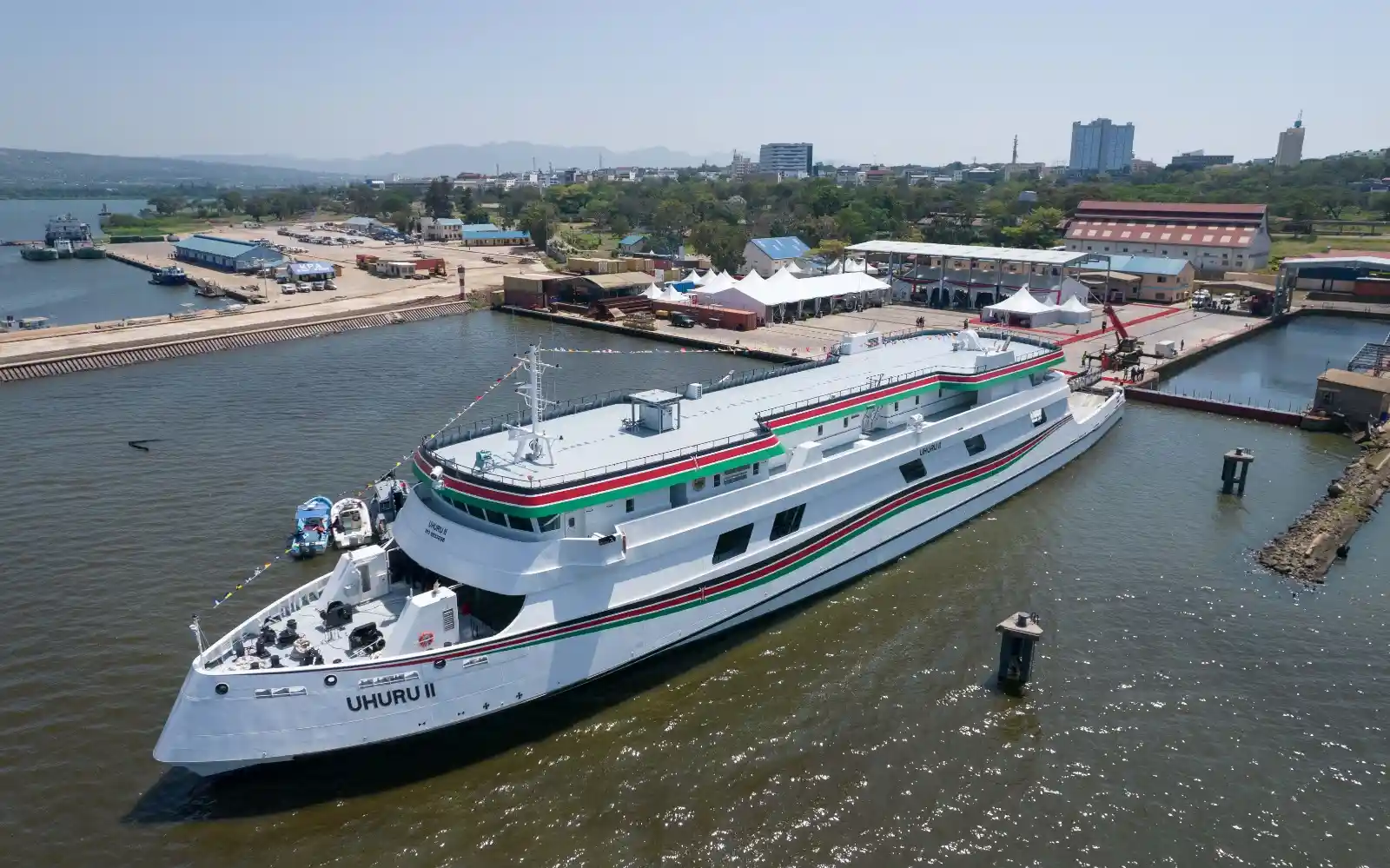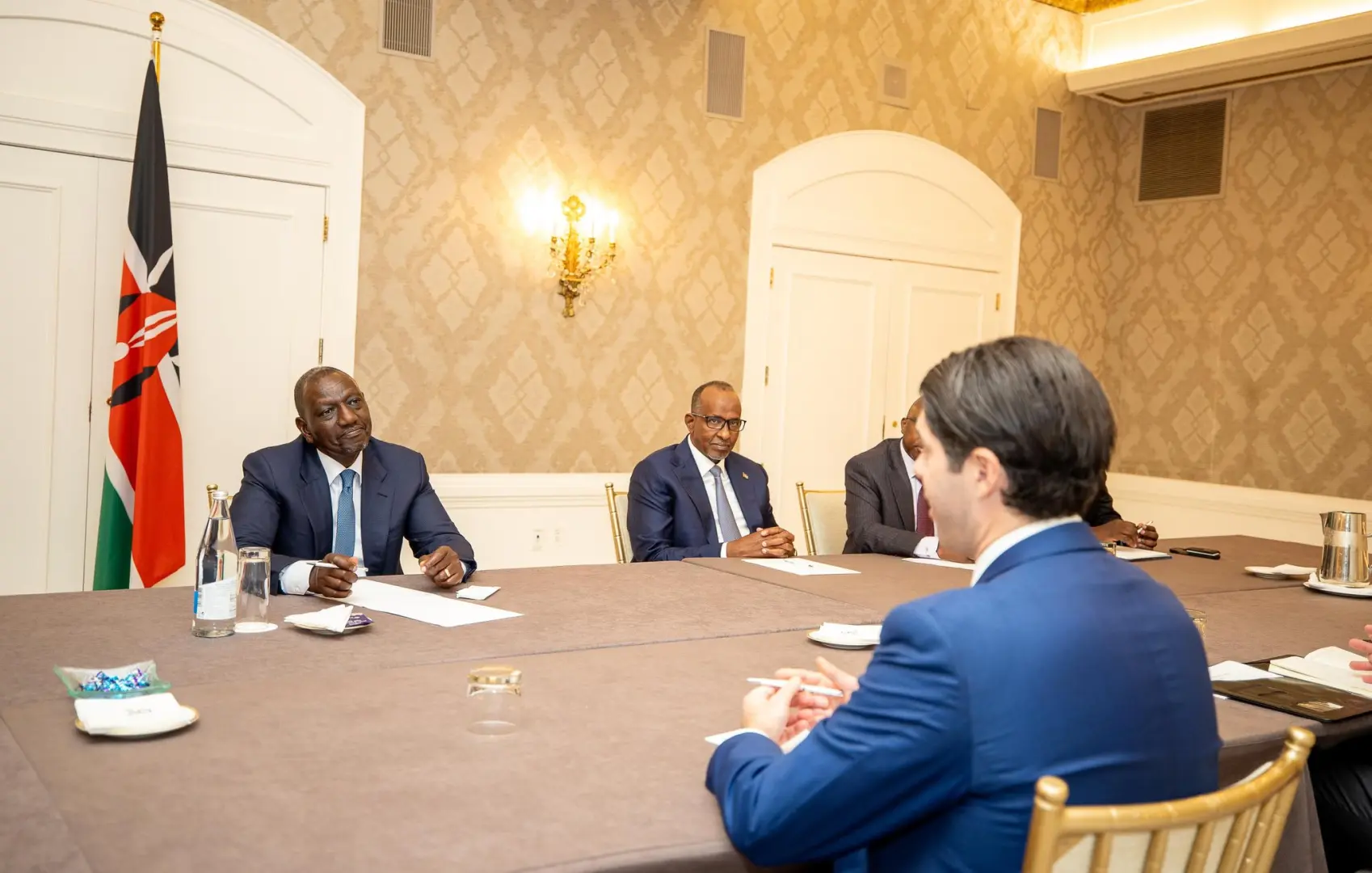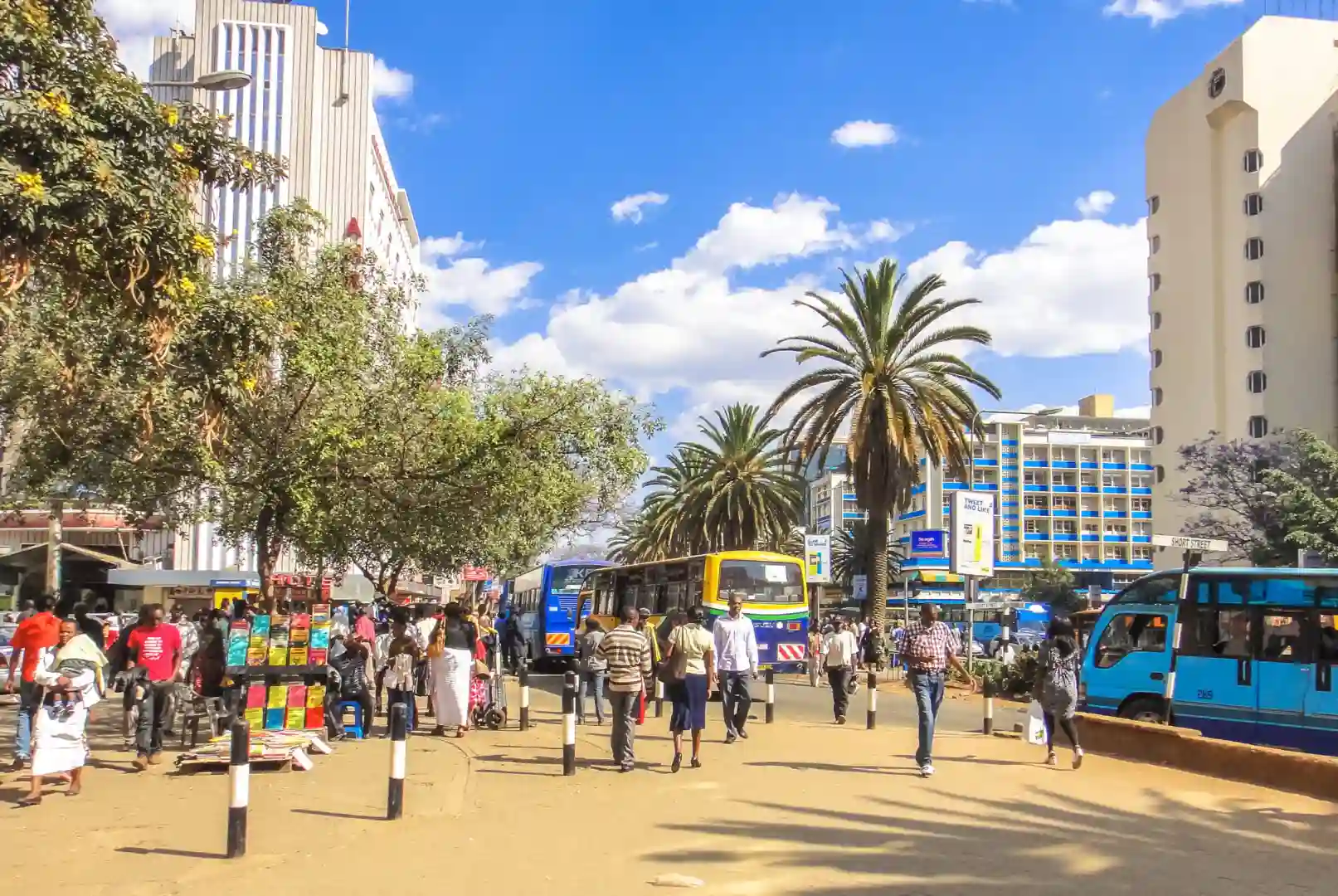In a momentous step marking a new era for Kenya’s maritime industry and regional connectivity, the construction of a state-of-the-art 29-metre ferry has officially commenced at the Kisumu Shipyard. This ambitious undertaking, a collaborative effort between Kenya Shipyards Limited (KSL) and Bangladesh-based Karnafuly Ship Builders Limited, is set to revolutionize passenger and vehicle transport across the vital waters of Lake Victoria, promising enhanced safety, efficiency, and economic vitality.
The pivotal milestone was celebrated with a high-profile keel-laying ceremony on June 19, 2025, a symbolic event that signals the physical start of a vessel’s construction. The event, steeped in naval tradition, was presided over by an esteemed lineup of dignitaries, including Defence Cabinet Secretary (CS) Soipan Tuya, and Mining and Blue Economy Cabinet Secretary Hassan Joho. Their presence underscored the national strategic importance and multi-sectoral impact of the project.
CS Tuya, in her address, lauded the initiative as a “landmark initiative in Kenya’s maritime development and a catalyst for regional integration.” Her words resonated with the national aspiration to harness the immense potential of Kenya’s blue economy. “Today’s keel-laying exercise for the construction of a 29-metre ferry is a testament that indeed we are on course towards the attainment of the ambition,” she declared, highlighting Kenya’s steadfast commitment to its long-term development goals.
The Symbolic Beginning: A Keel-Laying Ceremony
The keel-laying ceremony is one of the oldest and most significant traditions in shipbuilding, marking the formal start of a ship’s construction. Historically, it involved laying down the first timber of the keel, the backbone of a ship. In modern shipbuilding, with modular construction, it often signifies the placement of the first module or section of the ship’s bottom. This ceremony is not just a technical formality; it’s a profound symbolic act, often accompanied by blessings for the vessel and its future journeys. For Kenya, hosting such a ceremony for a locally built ferry marks a tangible step forward in its quest for maritime self-reliance.
The event at Kisumu Shipyard was graced by a distinguished array of leaders, reflecting the project’s broad impact. Alongside CS Soipan Tuya and CS Hassan Joho, notable attendees included Homa Bay Governor Gladys Wanga and Kisumu Deputy Governor Mathews Owili. Their presence emphasized the direct benefits that the ferry is expected to bring to the communities residing along the shores of Lake Victoria.
CS Tuya eloquently described the keel as a “symbol of strength and direction,” perfectly encapsulating the aspirations tied to the project. She emphasized that this initiative “marks the rise of a vibrant shipbuilding enterprise at the Port of Kisumu.” This vision goes beyond a single ferry; it envisions Kisumu as a burgeoning hub for naval and commercial vessel construction, a testament to Kenya’s growing industrial capabilities. The Defence Cabinet Secretary’s prominent role in a civilian transport project further highlights the strategic nexus between national security, economic development, and robust indigenous industrial capacity.
Kenya Shipyards Limited and Strategic Partnerships
The construction of the 29-metre ferry is a flagship project for Kenya Shipyards Limited (KSL), a state corporation established to spearhead Kenya’s shipbuilding and repair ambitions. KSL’s mandate is crucial for strengthening national security, enhancing maritime trade, and creating high-value jobs. The Kisumu Shipyard, strategically located on the shores of Lake Victoria, is a critical asset in this endeavor, poised to become a regional center of excellence for inland water vessel construction and maintenance.
KSL’s collaboration with Bangladesh-based Karnafuly Ship Builders Limited is a prime example of South-South cooperation, leveraging established expertise from a nation with a rich shipbuilding heritage. Bangladesh has a well-developed shipbuilding industry, particularly for smaller and medium-sized vessels. This partnership offers invaluable advantages for Kenya:
- Technology Transfer: KSL engineers and technicians will gain hands-on experience and knowledge from their Bangladeshi counterparts, accelerating the adoption of modern shipbuilding techniques and technologies. This transfer of intellectual capital is far more valuable than simply importing a finished vessel.
- Capacity Building: The joint venture enhances KSL’s capabilities, moving it closer to its goal of independent vessel construction and maintenance. This includes training in design, fabrication, welding, outfitting, and quality control.
- Efficiency and Quality Assurance: Karnafuly Ship Builders brings proven processes and quality standards that will ensure the ferry is built to international specifications.
- Cost-Effectiveness: Collaborative projects can often be more cost-effective than relying solely on foreign imports, while simultaneously building local industrial capacity.
This strategic partnership is a deliberate move by Kenya to reduce its reliance on foreign ship imports and establish a sustainable, self-sufficient shipbuilding industry. It aligns with the government’s broader “Buy Kenya, Build Kenya” policy, which promotes local manufacturing and value addition.
The 29-Metre Ferry: Design, Functionality, and Multi-faceted Impact
The upcoming ferry is meticulously designed to cater to both passengers and vehicles, making it a versatile asset for the diverse needs of the Lake Victoria basin. Its classification under Bureau Veritas, a world-leading inspection, certification, and testing agency, is a critical detail. This classification signifies that the ferry will be designed, constructed, and operated in compliance with stringent international safety, quality, and environmental standards. For passengers and cargo owners, this translates to:
- Improved Safety: Adherence to Bureau Veritas rules ensures the vessel’s structural integrity, machinery reliability, and safety systems meet rigorous international benchmarks, significantly reducing the risks associated with older, less regulated vessels.
- Enhanced Dependability: A classified vessel is built for longevity and consistent performance, leading to fewer breakdowns and more reliable service schedules, which is crucial for commerce and commuter confidence.
- Facilitation of Insurance and Financing: International classification makes it easier for the vessel to be insured and to secure financing, as it provides a recognized assurance of quality and risk management.
Beyond its technical specifications, the ferry’s operational impact is expected to be transformative. It will significantly improve “safe and efficient transport” across Lake Victoria, addressing long-standing challenges of inadequate and sometimes unsafe maritime infrastructure. This improvement in connectivity will directly “boost intermodal transport” – the seamless movement of goods and people using multiple modes of transport (e.g., road to ferry to rail). For instance, agricultural produce from remote island communities can be easily transported to larger markets, and manufactured goods can reach distant populations.
CS Tuya emphasized this economic nexus when addressing KSL engineers: “Every weld you place will support economic movement, every plate you align will strengthen the corridors of trade.” This highlights the direct link between precision engineering and broad economic benefits. She instilled a sense of national pride, urging them to “Build not only with precision but with pride. This ferry is yours, to connect, empower and carry your aspirations across the great expanse of progress.”
The vessel’s construction will follow a structured process, typical of modern shipbuilding, ensuring quality and efficiency:
- Design: Detailed blueprints and engineering plans.
- Procurement of Materials: Sourcing high-quality steel, engines, electronics, and other components.
- Modular Assembly: Building sections of the ferry independently before joining them.
- Outfitting: Installing machinery, piping, electrical systems, navigation equipment, and interior fittings.
- Painting: Applying protective coatings and aesthetic finishes.
- Sea Trials: Rigorous testing of the vessel’s performance, safety systems, and maneuverability in actual operating conditions.
- Commissioning: Official handover and entry into service.
This comprehensive process ensures that the final product is not only functional but also compliant with all safety and operational requirements, ready to serve the region for decades to come.
Lake Victoria: The Artery of East African Integration
Lake Victoria, Africa’s largest lake by area and the world’s largest tropical lake, is a shared natural resource bordered by Kenya, Uganda, and Tanzania. It serves as a vital economic lifeline for over 40 million people who live within its basin, directly impacting their livelihoods through fishing, agriculture, trade, and tourism. Despite its immense potential, CS Tuya correctly noted that “maritime infrastructure remains underdeveloped.” This long-standing challenge has hindered efficient cross-border trade, restricted access to markets for remote communities, and sometimes posed safety risks due to an aging fleet of vessels.
Historically, Lake Victoria was a bustling artery of trade during the colonial era, with steamers connecting various ports and facilitating the movement of goods and people. However, decades of underinvestment, deteriorating infrastructure, and increased reliance on road transport led to a decline in its maritime potential. The new ferry project is a direct response to this neglect, representing a “strategic investment in mobility, commerce, industrialisation, and integration.”
- Mobility: It provides a reliable means for people to travel between mainland and island communities, accessing essential services, education, and social connections.
- Commerce: The ability to transport goods efficiently and cost-effectively stimulates trade, supporting local businesses and farmers who can now reach broader markets. This reduces transport costs and enhances the competitiveness of goods produced in the lake region.
- Industrialization: A robust transport network supports industrial growth by facilitating the movement of raw materials to factories and finished goods to markets. The ferry itself is a product of industrialization efforts at Kisumu Shipyard.
- Integration: Perhaps most importantly, the ferry will act as a tangible link between the three East African Community (EAC) partner states sharing the lake. By facilitating cross-border travel for both passengers and vehicles, it strengthens economic and social ties, fostering a greater sense of regional unity and accelerating the realization of the EAC Common Market Protocol. This move is crucial for enhancing regional trade and tourism, making it easier for goods and people to move freely across the borders within the EAC.
Kenya’s Blue Economy and Bottom-Up Economic Transformation Agenda
The ferry project is intrinsically linked to Kenya’s broader national development agenda, particularly its focus on the Blue Economy and the Bottom-Up Economic Transformation Agenda (BETA).
The Blue Economy refers to the sustainable use of ocean and lake resources for economic growth, improved livelihoods, and jobs while preserving the health of the ecosystem. For Kenya, with its Indian Ocean coastline and shared inland lakes, this sector holds immense, largely untapped potential. Developing maritime infrastructure like ferries, upgrading ports, enhancing fisheries, and promoting marine tourism are all key components of this strategy. The involvement of the Mining and Blue Economy Cabinet Secretary, Hassan Joho, highlights the government’s cross-sectoral approach to this vital area. Joho specifically noted that the project will “reduce transport costs within the lake region” and provide a “safer, faster, and more cost-effective transport alternative,” directly translating blue economy potential into tangible benefits for citizens and businesses.
The Bottom-Up Economic Transformation Agenda (BETA) is the current administration’s flagship economic blueprint, focused on empowering ordinary Kenyans and creating opportunities from the grassroots level upwards. The ferry project aligns perfectly with BETA’s core tenets:
- Job Creation: The construction process itself, along with the future operation and maintenance of the ferry, generates “high-value jobs” for engineers, welders, designers, deckhands, and administrative staff. These are not just any jobs; they are skilled positions that build human capital and expertise within the country.
- Industrial Growth and Local Manufacturing: Building the ferry domestically, rather than importing it, strengthens Kenya’s manufacturing sector and promotes self-reliance. It boosts local industries that supply materials and services to the shipyard.
- Support for Small Businesses: Improved transport links benefit smallholder farmers, traders, and fishermen around Lake Victoria by giving them better access to markets and reducing logistical costs, directly impacting their livelihoods at the “bottom” of the economic pyramid.
- Infrastructure Development: Investing in critical infrastructure is a key pillar of BETA, as it unlocks productivity and connectivity across various sectors.
CS Tuya succinctly captured this synergy: “This is a long-term investment in self-reliance and regional leadership. Let us all support this transformation so that tomorrow, Kenya’s maritime industry sails further and serves more.” This vision of self-reliance through local industrialization is a powerful driver for national development.
Local Voices: Impact on Communities and Future Demands
The project has garnered significant support from local leaders, who see its immediate and long-term benefits for their constituents. Homa Bay Governor Gladys Wanga welcomed the initiative, highlighting its profound impact on remote communities. She stated that the ferry will “open up access for island communities in Homa Bay county currently locked out of public transport” and will be a “lifeline for isolated populations.” Many of these island communities have historically faced challenges in accessing healthcare, education, markets, and government services due to a lack of reliable transport. The new ferry will bridge this gap, integrating them more fully into the regional economy and social fabric.
Kisumu Deputy Governor Mathews Owili, while expressing appreciation for the new ferry, also seized the opportunity to advocate for further investment. He urged the Kenya Ports Authority (KPA), which oversees the Kisumu Shipyard, to “consider building an additional ferry specifically for Kisumu, citing growing demand.” This reflects the robust economic activity and increasing population density in and around Kisumu, which serves as a vital economic hub for the entire lake region. Owili also reiterated Kisumu County’s commitment to “supporting KSL through continued collaboration in the construction of fishing boats and maritime infrastructure,” signaling a desire for a sustained partnership that goes beyond this single ferry project, encompassing broader maritime development.
The local enthusiasm underscores the urgent need for improved maritime transport on Lake Victoria. The ferry is not just a vessel; it’s a symbol of hope and opportunity for millions, promising to unlock socio-economic potential that has long been constrained by inadequate infrastructure.
The Road Ahead: Challenges and Bright Prospects
While the keel-laying marks a triumphant beginning, the journey of shipbuilding is complex and demands sustained commitment. The construction will involve meticulous planning, coordination of specialized skills, and efficient supply chain management. Potential challenges could include:
- Timely Procurement of Materials: Ensuring a steady supply of high-quality steel and other components.
- Skilled Labor Development: Continuously training and retaining a workforce with the specialized skills required for shipbuilding.
- Financial Management: Ensuring adequate funding flows throughout the multi-stage construction process.
- Environmental Compliance: Adhering to strict environmental regulations during construction and operation to protect the delicate ecosystem of Lake Victoria.
However, the prospects are undeniably bright. This project is expected to significantly elevate Kenya’s maritime profile, both regionally and globally. By successfully building a modern, Bureau Veritas-classified ferry, Kenya demonstrates its capabilities and signals its ambition to become a formidable player in the regional shipbuilding economy. This achievement could open doors for:
- More Domestic Orders: Encouraging other Kenyan entities and county governments to commission locally built vessels.
- Regional Export Opportunities: Positioning KSL as a viable option for neighboring countries (Uganda, Tanzania, Rwanda, Burundi, DR Congo) seeking to develop their own inland water transport fleets.
- Increased Foreign Investment: Attracting further international partnerships and investments into Kenya’s nascent shipbuilding and maritime industries.
- Enhanced Research and Development: Fostering innovation in marine engineering and design within Kenya.
The transformation of Kisumu Shipyard into a bustling center of maritime construction will have a ripple effect, stimulating auxiliary industries and creating a vibrant ecosystem of related services. It is a long-term investment that promises to yield significant dividends in terms of economic growth, job creation, and regional integration, ultimately strengthening Kenya’s position as an economic powerhouse in East Africa.
Conclusion: A Foundation for a Prosperous Maritime Future
The keel-laying ceremony for the 29-metre ferry at Kisumu Shipyard is more than just the start of a construction project; it is a profound declaration of Kenya’s strategic intent to reclaim its maritime heritage and build a self-reliant future. This initiative, underpinned by robust government commitment, international partnership, and a clear vision for regional integration, represents a crucial step in unlocking the vast economic potential of Lake Victoria.
By emphasizing local manufacturing, fostering skills development, and adhering to international quality standards, Kenya is not just building a ferry; it is laying the foundation for a thriving shipbuilding industry. This move will not only provide safer and more efficient transport for millions across Kenya, Uganda, and Tanzania but also create thousands of high-value jobs, stimulate economic activities at the grassroots, and firmly establish Kenya as a maritime leader in East Africa. As the ferry takes shape, it will stand as a tangible symbol of progress, connecting communities, empowering commerce, and carrying the aspirations of a nation towards a prosperous and integrated future.
Ready to take your career to the next level? Join our dynamic courses: ACCA, HESI A2, ATI TEAS 7 , HESI EXIT , NCLEX – RN and NCLEX – PN, Financial Literacy!🌟 Dive into a world of opportunities and empower yourself for success. Explore more at Serrari Ed and start your exciting journey today! ✨
Photo source: Google
By: Montel Kamau
Serrari Financial Analyst
20th June, 2025
Article, Financial and News Disclaimer
The Value of a Financial Advisor
While this article offers valuable insights, it is essential to recognize that personal finance can be highly complex and unique to each individual. A financial advisor provides professional expertise and personalized guidance to help you make well-informed decisions tailored to your specific circumstances and goals.
Beyond offering knowledge, a financial advisor serves as a trusted partner to help you stay disciplined, avoid common pitfalls, and remain focused on your long-term objectives. Their perspective and experience can complement your own efforts, enhancing your financial well-being and ensuring a more confident approach to managing your finances.
Disclaimer: This article is for informational purposes only and does not constitute financial advice. Readers are encouraged to consult a licensed financial advisor to obtain guidance specific to their financial situation.
Article and News Disclaimer
The information provided on www.serrarigroup.com is for general informational purposes only. While we strive to keep the information up to date and accurate, we make no representations or warranties of any kind, express or implied, about the completeness, accuracy, reliability, suitability, or availability with respect to the website or the information, products, services, or related graphics contained on the website for any purpose. Any reliance you place on such information is therefore strictly at your own risk.
www.serrarigroup.com is not responsible for any errors or omissions, or for the results obtained from the use of this information. All information on the website is provided on an as-is basis, with no guarantee of completeness, accuracy, timeliness, or of the results obtained from the use of this information, and without warranty of any kind, express or implied, including but not limited to warranties of performance, merchantability, and fitness for a particular purpose.
In no event will www.serrarigroup.com be liable to you or anyone else for any decision made or action taken in reliance on the information provided on the website or for any consequential, special, or similar damages, even if advised of the possibility of such damages.
The articles, news, and information presented on www.serrarigroup.com reflect the opinions of the respective authors and contributors and do not necessarily represent the views of the website or its management. Any views or opinions expressed are solely those of the individual authors and do not represent the website's views or opinions as a whole.
The content on www.serrarigroup.com may include links to external websites, which are provided for convenience and informational purposes only. We have no control over the nature, content, and availability of those sites. The inclusion of any links does not necessarily imply a recommendation or endorsement of the views expressed within them.
Every effort is made to keep the website up and running smoothly. However, www.serrarigroup.com takes no responsibility for, and will not be liable for, the website being temporarily unavailable due to technical issues beyond our control.
Please note that laws, regulations, and information can change rapidly, and we advise you to conduct further research and seek professional advice when necessary.
By using www.serrarigroup.com, you agree to this disclaimer and its terms. If you do not agree with this disclaimer, please do not use the website.
www.serrarigroup.com, reserves the right to update, modify, or remove any part of this disclaimer without prior notice. It is your responsibility to review this disclaimer periodically for changes.
Serrari Group 2025












